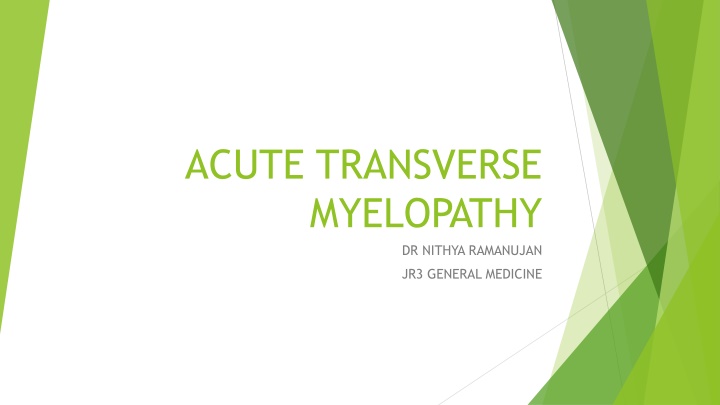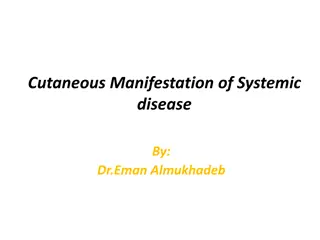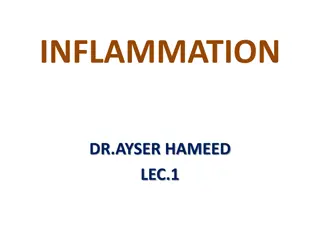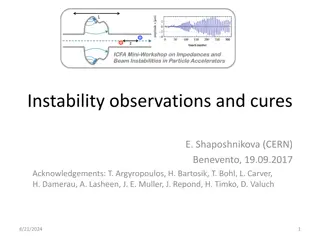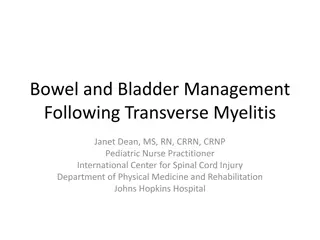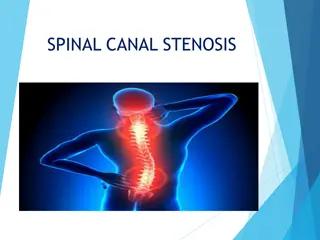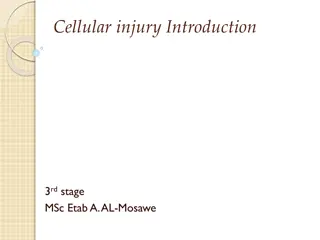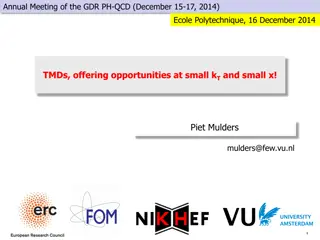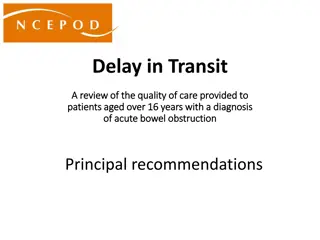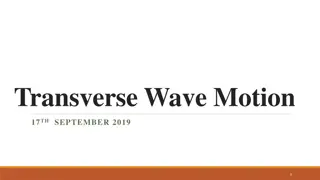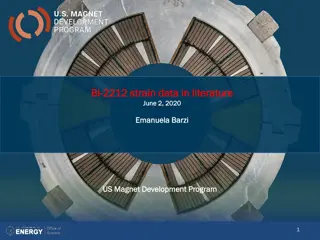Overview of Acute Transverse Myelopathy and Its Manifestations
Acute transverse myelopathy, a condition where spinal cord damage interrupts motor and sensory functions, can result from various causes such as traumatic injuries, tumors, and autoimmune disorders. Common symptoms include sensory disturbances, motor impairments like paraplegia, and potential autonomic dysfunctions. Diagnosis involves recognizing sensory and motor patterns below the lesion level. Proper identification and management are crucial for better outcomes.
Download Presentation

Please find below an Image/Link to download the presentation.
The content on the website is provided AS IS for your information and personal use only. It may not be sold, licensed, or shared on other websites without obtaining consent from the author.If you encounter any issues during the download, it is possible that the publisher has removed the file from their server.
You are allowed to download the files provided on this website for personal or commercial use, subject to the condition that they are used lawfully. All files are the property of their respective owners.
The content on the website is provided AS IS for your information and personal use only. It may not be sold, licensed, or shared on other websites without obtaining consent from the author.
E N D
Presentation Transcript
ACUTE TRANSVERSE MYELOPATHY DR NITHYA RAMANUJAN JR3 GENERAL MEDICINE
Complete spinal cord transection All ascending tracts from below the level of the lesion All descending tracts from above the level of the lesion interrupted Impairment of all motor and sensory functions below the level of spinal cord damage More often, section is incomplete
Etiologies Common causes- Traumatic spine injuries Tumors Multiple sclerosis Vascular disorders Less common- Spinal epidural hematomas or abscess Paraneoplastic myelopathy Autoimmune disorders Herniated intervertebral disc Parainfectious or postvaccinal syndromes
Sensory disturbance Band-like radicular pain or segmental paresthesias- at the level of the lesion Radiation of pain Cervical- to the arms Thoracic- circumferentially to the chest or abdomen Lumbar or sacral- to the legs Localized vertebral pain Accentuated by palpation or vertebral percussion destructive lesions Pain that is worse with recumbence Improving when sitting or standing malignancy
All sensory modalities- impaired below the level of the lesion Pin-prick loss below a segmental level- most valuable A sensory level may be easily missed Extramedullary lesions -sensory level may be many segments below the level of the lesion eg: high thoracic lesions may present with levels in the upper lumbar segments
Motor disturbances Paraplegia or quadriplegia- interruption of the descending corticospinal tracts Acute lesions- flaccid and areflexic because of hypoexcitability of the spinal cord (spinal shock) Eventually, hypertonic, hyperreflexic paraplegia or tetraplegia, with bilateral Babinski signs, loss of superficial abdominal and cremasteric reflexes, extensor and flexor spasms At the level of the lesion- segmental LMN signs (paresis, atrophy, fasciculations, and areflexia) due to damage to AHC s or roots
Autonomic disturbances Urinary or rectal dysfunction- bilateral lesion Urgency of micturition, urinary retention or incontinence/ constipation Initially atonic spastic rectal and bladder sphincter dysfunction (lesions at any spinal level) Orthostatic hypotension Anhidrosis Trophic skin changes Impaired temperature control Vasomotor instability Sexual dysfunction
Compressive and noncompressive myelopathy Exclude treatable compression of the cord by a mass lesion Common causes -tumor, epidural abscess or hematoma, herniated disk, spondylitic vertebral pathology Epidural compression due to malignancy or abscess- warning signs (neck or back pain, bladder disturbances, sensory symptoms) that precede the development of paralysis Spinal subluxation, hemorrhage, and noncompressive etiologies -produce myelopathy without antecedent symptoms Magnetic resonance imaging (MRI) with gadolinium- to exclude compressive Evaluate for noncompressive causes of acute myelopathy (vascular, inflammatory, infectious etiologies)
Non compressive causes Spinal cord infarction Systemic inflammatory disorders- SLE, sarcoidosis Demyelinating diseases-multiple sclerosis, neuromyelitis optica Post infectious Idiopathic transverse myelitis- immune condition related to acute disseminated encephalomyelitis and infectious causes
Inflammatory & immune myelopathy (myelitis) Demyelinating Systemic inflammatory Post infectious One quarter cases of myelits- no cause can be identified Recurrent episodes of myelitis - immune mediated disease, HSV-2
Multiple sclerosis Can present as acute myelitis- Asians, Africans In Caucasians partial cord syndrome Symptoms MRI spine - mild swelling of cord -diffuse or multifocal shoddy areas of abnormal signal (T2WI) -contast enhancement (disruption of BBB associated with inflammation)
In one study 68% patients presenting with partial myelitis developed MS after mean follow up of 4 yrs Risk factors for conversion to MS age <40 inflammatory CSF >3 periventricular lesions in brain MRI Treatment iv methylprednisolone (500 mg qd for 3 days) followed by oral prednisone (1 mg/kg/d for several weeks, then gradual taper) plasma exchange -for severe cases if glucocorticoids are ineffective
Neuromyelitis optica immune-mediated demyelinating disorder severe myelopathy - typically longitudinally extensive (the lesion spans three or more vertebral segments) Other involvement -optic neuritis (often bilateral) may precede or follow myelitis by weeks or months -Brainstem -Hypothalamic -Focal cerebral white matter involvement Recurrent myelitis without optic nerve or other involvement
CSF studies -variable mononuclear pleocytosis (several hundred cells per microliter), oligoclonal bands are absent Diagnostic serum autoantibodies against the water channel protein aquaporin-4 60 70% of patients with NMO Less commonly autoantibodies against the CNS myelin protein myelin oligodendrocyte glycoprotein (MOG)
No definitive treatment Acute relapses glucocorticoids Refractory cases- plasma exchange Prophylactic treatment with azathioprine, mycophenylate, or rituximab may protect against subsequent relapses (5 years or longer is generally recommended)
Systemic immune mediated disorders SLE Sarcoidosis Antiphospholipid antibody syndrome Mixed connective tissue disease Beh et s syndrome Vasculitis related to polyarteritis nodosa, p-ANCA, or primary CNS vasculitis
SLE related Myelitis- small number of patients with SLE Many cases are associated with antibodies to aquaporin-4, meets diagnostic criteria for NMO- spectrum disorder High risk of developing future episodes of myelitis and/or optic neuritis In others the etiology of SLE-associated myelitis- uncertain APLA ab may be seen- but not significant CSF in NMO-associated myelitis typically shows a pleocytosis with polymorphonuclear leukocytes, no oligoclonal bands In cases not due to NMO a mild lymphocytic pleocytosis and oligoclonal bands Treatment Based on limited data, high-dose glucocorticoids followed by cyclophosphamide plasma exchange
Sjogrens syndrome Associated with NMO-spectrum disorder Cases of chronic progressive myelopathy
Sarcoid myelopathy Present as a slowly progressive or relapsing disorder Systemic manifestations of sarcoid Typical neurologic manifestations- cranial neuropathy, hypothalamic involvement, or meningeal enhancement on MRI CSF profile- mild lymphocytic pleocytosis, mildly elevated protein level. In some reduced glucose and oligoclonal bands are found
MRI - edematous swelling of the spinal cord that may mimic tumor Gadolinium enhancement of active lesions Nodular enhancement of the adjacent surface of the cord Lesions may be single or multiple On axial images- enhancement of the central cord Diagnosis Difficult when systemic manifestations of sarcoid are minor or absent (nearly 50% of cases) or when other typical neurologic manifestations of the disease are lacking
CSF study MRI spine Slit-lamp examination of the eye to search for uveitis Chest x-ray and CT to assess pulmonary involvement and mediastinal lymphadenopathy Serum or CSF angiotensin-converting enzyme (ACE) Serum calcium Gallium scan
Treatment oral glucocorticoids- initially Resistant cases -immunosuppressant drugs, including TNF- inhibitor infliximab
POSTINFECTIOUS MYELITIS postinfectious or postvaccinal myelitis follow an infection or vaccination Implicated- EBV, CMV, mycoplasma, influenza, measles, varicella, mumps, yellow fever As in the related disorder acute disseminated encephalomyelitis, postinfectious myelitis often begins as the patient appears to be recovering from an acute febrile infection, or in the subsequent days or weeks, but an infectious agent cannot be isolated from the nervous system or CSF Presumption is myelitis represents an autoimmune disorder triggered by infection and not due to direct infection of the spinal cord No definitive therapy Treatment- glucocorticoids, in fulminant cases plasma exchange
Infectious myelitis Viral Herpes zoster, HSV types 1 and 2, EBV, CMV, rabies virus, Zika virus HSV-2 (less commonly HSV-1) - distinctive syndrome of recurrent sacral cauda equina neuritis in association with outbreaks of genital herpes (Elsberg s syndrome) Poliomyelitis is the prototypic viral myelitis, but it is restricted to the anterior gray matter of the cord containing the spinal motoneuron Polio-like syndrome- enteroviruses (enterovirus 71 and coxsackie), JE, West Nile virus Chronic viral myelitic infections- HIV or HTLV-1
In suspected viral myelitis, appropriate to begin specific therapy Herpes zoster, HSV, and EBV myelitis- iv acyclovir (10 mg/kg q8h) or oral valacyclovir (2 g tid) for 10 14 days CMV- ganciclovir (5 mg/kg IV bid) plus foscarnet (60 mg/kg IV tid) or cidofovir (5 mg/kg per week for 2 weeks)
Bacterial and mycobacterial myelitis Most are essentially abscesses, are less common than viral causes Less frequent than cerebral bacterial abscess Borrelia burgdorferi (Lyme disease) Listeria monocytogenes Mycobacterium tuberculosis Treponema pallidum (syphilis) Mycoplasma pneumoniae
Parasitic myelitis Schistosomiasis- endemic areas Intensely inflammatory and granulomatous reaction, caused by a local response to tissue-digesting enzymes from the ova of the parasite Schistosoma hematobium or Schistosoma mansoni Toxoplasmosis -occasionally cause a focal myelopathy -should especially be considered in patients with AIDS Cysticercosis- another consideration, far less common than parenchymal brain or meningeal involvement
High voltage electrical injury Spinal cord injuries are prominent following electrocution from lightning strikes or other accidental electrical exposures Syndrome consists of transient weakness acutely (often with an altered sensorium and focal cerebral disturbances) After several days or even weeks - severe and permanent myelopathy Rare injury type Limited data incriminate a vascular pathology involving ASA and its branches in some cases Therapy- supportive
